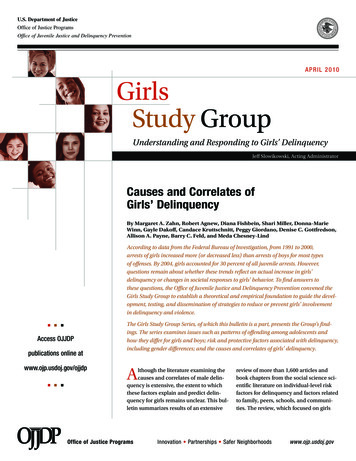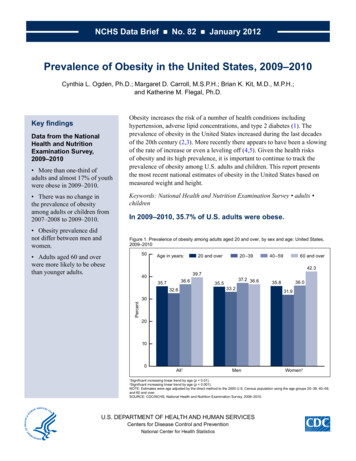
Transcription
U.S. Department of JusticeOffice of Justice ProgramsOffice of Juvenile Justice and Delinquency PreventionA P ri l 2 0 1 0GirlsStudy GroupUnderstanding and Responding to Girls’ DelinquencyJeff Slowikowski, Acting AdministratorCauses and Correlates ofGirls’ DelinquencyBy Margaret A. Zahn, Robert Agnew, Diana Fishbein, Shari Miller, Donna-MarieWinn, Gayle Dakoff, Candace Kruttschnitt, Peggy Giordano, Denise C. Gottfredson,Allison A. Payne, Barry C. Feld, and Meda Chesney-LindAccording to data from the Federal Bureau of Investigation, from 1991 to 2000,arrests of girls increased more (or decreased less) than arrests of boys for most typesof offenses. By 2004, girls accounted for 30 percent of all juvenile arrests. However,questions remain about whether these trends reflect an actual increase in girls’delinquency or changes in societal responses to girls’ behavior. To find answers tothese questions, the Office of Juvenile Justice and Delinquency Prevention convened theGirls Study Group to establish a theoretical and empirical foundation to guide the devel opment, testing, and dissemination of strategies to reduce or prevent girls’ involvementin delinquency and violence.nnnAccess OJJDPpublications online atwww.ojp.usdoj.gov/ojjdpnnnThe Girls Study Group Series, of which this bulletin is a part, presents the Group’s find ings. The series examines issues such as patterns of offending among adolescents andhow they differ for girls and boys; risk and protective factors associated with delinquency,including gender differences; and the causes and correlates of girls’ delinquency.Although the literature examining thecauses and correlates of male delinquency is extensive, the extent to whichthese factors explain and predict delinquency for girls remains unclear. This bulletin summarizes results of an extensiveOffice of Justice Programsreview of more than 1,600 articles andbook chapters from the social science sci entific literature on individual-level riskfactors for delinquency and factors relatedto family, peers, schools, and communi ties. The review, which focused on girlsInnovation Partnerships Safer Neighborhoods
Girls Study Groupdeclined by 4 percent for boys, whereasthe rate for girls increased by 19 per cent. Arrest data, however, are inad equate in helping to understand thefactors that lead to girls’ offending andarrests. To better understand the causesand correlates of girls’ delinquency,this bulletin examines evidence fromresearch studies that have explored thedynamics of girls’ delinquency and riskbehavior.Data Limitationsages 11 to 18, also examined whetherthese factors are gender neutral, genderspecific, or gender sensitive.This bulletin defines delinquency as theinvolvement of a child younger than 18in behavior that violates the law. Suchbehavior includes violent crime, prop erty crime, burglary, drug and alcoholabuse, and status offenses (i.e., behav iors that would not be criminal if com mitted by an adult) such as runningaway, ungovernability, truancy, andpossession of alcohol.According to arrest statistics from theFederal Bureau of Investigation, theoverall rate of juvenile arrests decreasedfrom 1994 to 2004 (Snyder, 2008). Morespecifically, the arrest rate for violentcrimes over this period decreased 49percent. The violent crime arrest ratethen increased in 2005 by 2 percent,with a 4-percent increase in 2006.However, these overall rates obscureimportant variations in rates by gender.From 1997 to 2006, arrests for aggra vated assaults decreased more for boys(24 percent) than for girls (10 percent).In addition, arrests for simple assault2Research indicates that risk and pro tective factors for delinquency maybe different for boys and girls, but themechanisms behind these differencesare unclear. Delinquency research hasseveral limitations. First, issues of selec tion bias when studying institutionalpopulations have led to an increaseduse of cohort, neighborhood, school,and community surveys. Many of thesestudies rely on self-reports of delin quency by youth, who may overstateor understate delinquent behavior. Onthe other hand, analyses that rely onarrest data or on adult observationaldata typically understate the frequencyof delinquent behavior. In addition,most delinquency studies are basedon samples of boys, and it is unclearwhether the same risk and protectivefactors apply equally well to girls. Muchof the literature on girls’ delinquencyis based on small, nonrepresentativesamples with few longitudinal studiesor comparison groups. While recogniz ing these limitations, it is importantto review the research to shed light onthis issue and identify topics in need offurther exploration.Characteristics of DelinquentBehavior by GirlsOn the whole, girls’ delinquent actsare typically less chronic and oftenless serious than those of boys (SnyderGirlsStudy GroupMembersDr. Stephanie r. Hawkins, PrincipalInvestigator, Girls Study Group (April 2008–Present) Research Clinical Psychologist,RTI InternationalDr. Margaret A. Zahn, Principal Investigator,Girls Study Group (2004–March 2008)Senior Research Scientist, RTI International;Professor, North Carolina State UniversityDr. robert Agnew, Professor, Department ofSociology, Emory UniversityDr. Meda Chesney-lind, Professor, Women’sStudies Program, University of Hawaii–ManoaDr. Gayle Dakof, Associate Research Professor,Department of Epidemiology and Public Health,University of MiamiDr. Del Elliott, Director, Center for the Study andPrevention of Violence, University of ColoradoDr. Barry Feld, Professor, School of Law,University of MinnesotaDr. Diana Fishbein, Director, TransdisciplinaryBehavioral Science Program, RTI InternationalDr. Peggy Giordano, Professor of Sociology,Center for Family and Demographic Research,Bowling Green State UniversityDr. Candace Kruttschnitt, Professor,Department of Sociology, University of TorontoDr. Jody Miller, Associate Professor,Department of Criminology and Criminal Justice,University of Missouri–St. LouisDr. Merry Morash, Professor, School ofCriminal Justice, Michigan State UniversityDr. Darrell Steffensmeier, Professor, Depart ment of Sociology, Pennsylvania State UniversityMs. Giovanna Taormina, Executive Director,Girls Circle AssociationDr. Donna-Marie Winn, Senior ResearchScientist, Center for Social Demography andEthnography, Duke University
Understanding and Responding to Girls’ Delinquencyand Sickmund, 2006). Minor offensespredominate among female delinquentoffenders.However, minor offenses may maskserious problems that girls are experi encing. Running away from home andother status offenses (such as truancy)are major components of girls’ delin quency. Studies of girls who are chronicrunaways document significant levels ofsexual and physical victimization (Feitelet al., 1992; Stiffman, 1989; Welsh et al.,1995). This suggests that although theiroffense behavior may not appear to bevery serious, these girls may be fleeingfrom serious problems and victimiza tion, some involving illegal behaviorby adults, which in turn makes themvulnerable to subsequent victimizationand engaging in other behaviors thatviolate the law such as prostitution,survival sex,1 and drug use. Similarly,research on aggression in girls andassaults committed by girls suggeststhat these behaviors can be best under stood in the context of their families,peer groups, schools, communities,and experiences (Brown, 1998; Caspi etal., 1993; Champion and Durant, 2001;Johnson, 2002; Leitz, 2003; Lockwood,1997; Margolin and Gordis, 2000;Molnar et al., 2005; Warr, 1996).Biological andIndividual FactorsBiological FactorsResearch conducted to date suggeststhat subtle differences in certain biolog ical functions and psychological traitsmay contribute to gender-related varia tions in responses to certain environ mental conditions (Klein and Corwin,2002). These basic differences may,in effect, partially account for ways inwhich girls’ delinquency is contrastedwith that of boys. However, the paucityof studies specific to girls’ delinquencythat include biological factors precludesany definitive conclusions at this time.One theoretical model for understand ing individual-level factors in girls’delinquency proposes that althoughsimilar risk factors may play a rolein both girls’ and boys’ delinquency,gender differences in underlying bio logical functions, psychological traits,and social interpretations can result indifferent types and rates of delinquentbehaviors for girls and boys (Moffitt etal., 2001). Another theory suggests thatboys and girls are differentially exposedto certain risk conditions, placingthem at variable risk for certain typesof delinquency. For example, there isevidence that girls experience a greaternumber of negative life events duringadolescence than boys, and they may,in turn, be more sensitive to their ef fects, particularly when they emanatefrom within the home (Ge et al., 1994).Further research is critical to deter mine the extent to which and how bio logical factors play a role in differencesbetween girls’ delinquent behavior andthat of boys.Stressors, Trauma, andMental HealthExposure to severe or cumulativestressors—and responses to them—are strongly associated with risktaking behavior, including delinquen cy. Stressors are conditions that elicitstrong negative responses and that areperceived as uncontrollable and unpre dictable. Such conditions producealterations in the body’s stress respons es that disrupt cognitive and emotionalprocesses, thereby increasing the likeli hood of risky behaviors in vulnerableadolescents (McBurnett et al., 2005;Sinha, 2001). Although this is true forboth boys and girls, studies have iden tified some gender differences in ratesand types of exposure to stressors. Forexample, although girls in the juvenilejustice system are more likely to havea history of abuse and neglect thannonjustice-involved girls (Berlingerand Elliot, 2002), there is further evi dence that girls more often experiencecertain types of trauma (e.g., sexualabuse and rape) than boys (Hennesseyet al., 2004; Snyder, 2000). Many studiesof special populations suggest that theincidence of sexual abuse is more per vasive among girls who engage in anti social behavior, particularly those whoengage in violent behavior, than amongtheir male counterparts (Poe-Yamagataand Butts, 1996; Smith, Leve, andChamberlain, 2006; Snell, 1994). Onthe other hand, the incidence of physi cal abuse appears to be more equallydistributed between boys and girls inadjudicated populations (Acoca, 1998;Funk, 1999; Henggeler, Edwards, andBorduin, 1987; Lederman et al., 2004;Lenssen et al., 2000; Mason, Zimmer man, and Evans, 1998; Shelton, 2004;Wood et al., 2002), but for both at amuch higher rate than in the generalpopulation (Leve and Chamberlain,2004), thus constituting a significantrisk factor overall. In addition to gen der differences in exposure to certainstressors, girls and boys may also varyin their sensitivity to the same stressor.For example, there is some suggestionGender Sensitivity to Risk FactorsBoys and girls experience many of the same risk factors, but they appear to differin sensitivity to and rates of exposure to these factors. For example, sexual assaultis a risk factor for both boys and girls, but the rate of exposure to this risk factor isgreater for girls.3
Girls Study Groupthat girls may be more sensitive to dys function and trauma within the home(Dornfield and Kruttschnitt, 1992; Rob ertson, Bankier, and Schwartz, 1987;Widom, 1991).Gender differences have also beennoted in mental health risk factorsfor delinquency. For example, boysoutnumber girls by a ratio of 3:1 inthe diagnoses of attention-deficit/hyperactivity disorder (ADHD) andconduct disorder, which are known riskfactors for problem behavior and delin quency in boys (Barbaresi et al., 2002;Lahey et al., 1999; Offord, Boyle, andRacine, 1989). Although girls exhibitlower levels of delinquency associatedwith these disorders (Moffitt et al., 2001;Satterfield and Schell, 1997), mentalhealth problems linked to life stressorsand experiences of victimization, such asdepression, anxiety, and posttraumaticstress disorder, are diagnosed at muchhigher rates among girls than boys.Although these disorders are also asso ciated with delinquency among boys,the relationship appears to be muchstronger for girls (Teplin et al., 2002).Early Onset of PubertyEarly puberty in girls has been associ ated with family dysfunction (Ellis andGarber, 2000; Moffitt et al., 1992). Also,early puberty interacts with mentalhealth disorders, ADHD, and cognitiveand emotional deficits to potentiallyworsen behavioral outcomes (Ge, Con ger, and Elder, 1996; Graber et al., 1997;Hayward et al., 1997; Kaltiala-Heinoet al., 2003; Orr and Ingersoll, 1995;Rieder and Coupey, 1999). Althoughthe timing of puberty is also a potentialrisk factor for boys, early maturationcreates particular risks for girls becauseof the development of physical signs ofmaturity inconsistent with still largelyundeveloped cognitive and emotionalsystems (Graber, Brooks-Gunn, andWarren, 1999).Several studies suggest that earlymaturing girls are more likely to engagein delinquency and other risk-takingbehaviors. A longitudinal study of931 males and females (Graber et al.,2004) found that early onset of pubertyamong girls continued to predictincreased risk behavior into adulthood.Some studies find that compared withother girls, early-maturing girls are atincreased threat of various high-riskbehaviors such as substance abuse,running away, and truancy (Caspi andMoffitt, 1991; Flannery, Rowe, and Gul ley, 1993; Graber et al., 1997; KaltialaHeino et al., 2003, Lanza and Collins,2002; Paikoff and Brooks-Gunn, 1991;Stattin and Magnusson, 1989; Stice,Presnell, and Bearman, 2001). Earlymaturation in girls also appears to bea risk factor in exposure to intimatepartner violence in adolescence (Foster,Hagan, and Brooks-Gunn, 2004).Moffitt (1993) contends that adoles cents experience a “maturity gap”between their level of biological devel opment and their desire to attain adultstatus. For some adolescents, delin quency may be an attempt to achieveindependence and autonomy fromparental control and to evidence matu rity in the social realm.Peer and Parent Relationshipsand Early PubertyEarly-onset puberty in girls is associ ated with having an adult boyfriend,which, in turn, affects the associationbetween early puberty and delinquency(Castillo Mezzich et al., 1997). Earlymaturing girls are more likely to date atyounger ages and to affiliate with oldermales who may be inclined towarddelinquent activity and involve the girlsin their antisocial behavior (Stattin andMagnusson, 1990; Weichold, Silbe reisen, and Schmitt-Rodermund, 2003).Among early-maturing girls whoundergo a difficult transition to ado lescence, the presence of preexistingbehavioral problems appears to accen tuate vulnerability to delinquency (Ge,Conger, and Elder, 1996). Peer andparent relationships are important fac tors in explaining links between girls’early maturation and delinquency. Theonset of puberty is traditionally associ ated with increased conflict betweenparents and teens around issues suchas dating, selecting friends, and chang ing behavioral expectations (Paikoffand Brooks-Gunn, 1991). Using data4
Understanding and Responding to Girls’ Delinquencyon 5,477 females from the NationalStudy of Adolescent Health (AddHealth), Haynie (2003) found that ear lier puberty among girls was associatedwith higher levels of delinquency andthat conflict with parents, exposureto peer deviance, and involvement inromantic relationships strengthenedthe link between early puberty anddelinquency.Parents’ behaviors also appear to mod erate the association between earlypuberty and later outcomes. Studieshave found that early-maturing chil dren whose parents use harsh andinconsistent discipline are more likelyto develop behavioral problems thanchildren of parents with more positiveparenting styles (Ge et al., 2002).In this way, harsh parenting ampli fies the association between pubertaltiming and behavior problems. Thisresult highlights how a biological factor,such as pubertal timing, can interactwith parenting processes in predictingbehavior problems.School and NeighborhoodContexts and Early PubertyEnvironment has also been shown toplay a part in the link between early mat uration and vulnerability to delinquen cy. Findings from Caspi et al. (1993) sug gest that the impact of early maturationcan be affected by the gender composi tion of schools. These authors found thatearly-maturing girls in mixed-genderschool settings were at greater risk fordelinquency than early-maturing girlsin same-gender school settings. Neigh borhoods can exert crucial influencesas well. In a study of a large and diversesample from Chicago neighborhoods,Obeidallah et al. (2004) found that girlswho experience early-onset puberty andlive in highly disadvantaged neighbor hoods—characterized by poverty, highunemployment, and a high percentageof single-parent households—are atsignificantly greater risk for exhibitingviolent behaviors than are those who livein less disadvantaged neighborhoods.In summary, contextual variables suchas school, parenting, and neighbor hood may exacerbate or ameliorate therelationships between early pubertyand problem outcomes. Early puberty,especially when coupled with familyconflict and disadvantaged neighbor hoods, is a key gender-sensitive factorin girls’ delinquency.Family InfluencesFamily issues such as inconsistentor lax supervision and various formsof abuse are some of the most stud ied links to juvenile delinquency.Researchers theorize that girls havestronger connections to family thanboys do throughout life (Gecas andSeff, 1990; Gilligan, 1982; Leonard,1982) and that this connection oftenserves as a protective factor. The theoryfollows that when this protective bondis weakened by instability, violence,sexual abuse, and/or lack of parentalsupervision, girls may engagein more risk-takingbehaviors, which inturn may lead todelinquency.Parental Supervisionand AttachmentComplex family processes such asattachment, parental supervision, andmaltreatment are important factorsthat help explain the difference in theonset of delinquency between girls andboys. In their landmark study, Mof fitt and colleagues (2001) followed acohort of 1,000 male and female chil dren, taking into account extrafamilialfactors and individual differences.Eight family factors were significantlycorrelated with delinquency for bothgirls and boys.2 Although most of thesefactors had a stronger relationship toboys’ delinquency than to girls’, the dif ference was relatively small.Findings on attachment, althoughcommonly more associated with girlsthan boys, are inconsistent across stud ies, in part because the concept is dif ficult to measure.Findings on effects of parental super vision and monitoring are statisti cally stronger. Consistent parentalsupervision and monitoring seem to5
Girls Study Groupprotect children and adolescents (girlsand boys) from involvement in delin quency (Cernkovich and Giordano,1987; Hirschi, 1969; Schlossman andCairns, 1993). In a comprehensivestudy of family dynamics (Patterson,Crosby, and Vuchinich, 1992), parentalmonitoring was found to protect youth.Conversely, ineffective parenting prac tices such as inconsistent discipline andrepeated faultfinding frequently fol lowed by explosive outbursts character ized families of delinquent youth morethan families of nondelinquent youth.Chamberlain (2003) also documentedthese types of negative family processesin the backgrounds of delinquent girls.Family CriminalityCriminality of parents and other fam ily members has long been considereda risk factor for delinquency (Glueckand Glueck, 1950; McCord, 1991;Rowe and Farrington, 1997), but hasnot been extensively studied in girls.Some qualitative studies in the 1980ssuggested that women involved inprostitution and other illegal street-lifesurvival strategies were introduced tothis behavior by cousins, young aunts,and other relatives who were them selves heavily involved in street life(e.g., Miller, 1986), and that children ofdrug-using parents are at high risk forantisocial behavior (Brown and Mills,1987). Giordano and Mohler-Rockwell(2001) studied the effect of familialcriminality on the delinquent involve ment of girls in a state juvenile justicefacility. Researchers found that familymembers such as mothers, grandmoth ers, siblings, and aunts—many of whomwere criminally involved—encouragedgirls to shoplift and some even taughttheir daughters to smoke crack.Similarly, Gaarder and Belknap (2002)studied girls arrested for serious offens es and found that their backgroundscommonly included sexual abuse as6children, victimization by intimate part ners, parental deviance, and parentaldrug use.Family instabilityFamily instability, with consequent dis ruptions in social ties and continuity ofeducation, also appears to be a factorin the development of erratic or disrup tive behavior among youth. Keller andcolleagues (2002) focused on parentaltransitions (i.e., residential moves and/or changes in parental caretakers) amongthe children of drug-using parents andfound that a greater number of transitionswere significantly associated with druguse and delinquency by the child. Thedelinquency effect was the same for boysand girls; the drug use effect was foundfor girls only. This finding of differenteffects with regard to gender strengthenssupport for the argument that girls andboys have different developmental pro cesses which may operate independentof family disruption.MaltreatmentEmpirical evidence consistently sug gests that family dysfunction andchild maltreatment increase the risk ofdelinquency and criminal offending ingirls (and boys). However, very little isknown about how this process works,i.e., the effects of specific types of familyrisk factors, maltreatment character istics (victim-perpetrator relationship,the victim’s age, the duration of mal treatment), the presence of mediatingfactors, and gender. Some evidencesuggests that the timing and durationof maltreatment, as well as interven ing life events, can either strengthen orweaken the negative effects of maltreat ment (Ireland, Smith, and Thornberry,2002; Leiter, Myers, and Zingraff, 1994).Accordingly, it may be premature toconclude that the effect of maltreat ment on delinquency development isgreater for girls than for boys or thatits effect on girls is greater than that ofother risk factors.Attention to the developmental effectsof maltreatment, particularly to effectsof childhood physical and sexual abuse,increased dramatically during the 1990swith the publication of findings fromseveral prospective longitudinal studies.These findings indicate that a history ofabuse and neglect significantly increasesthe chances of having both a juvenileand an adult criminal record (Widom,1989a, 1991). Empirical evidence alsoindicates that girls who perpetrate vio lence often have a history of violencecommitted against them (Herrera andMcCloskey, 2001; Margolin and Gordis,2000; Molnar et al., 2005; Song, Singer,and Anglin, 1998; Spohn, 2000; Widom,1989a, 1989b, 1989c, 1991, 1995).In her prospective cohort study, Widomfound that children who had experi enced severe child abuse or neglect wereat significantly higher risk for juvenilearrest compared to the matched controlgroup (Widom and Ames, 1994; Widomand Maxfield, 2001). By young adult hood, those reported as severely abusedor neglected as children were 59 percentmore likely to have been arrested forany offense as a juvenile and 28 percentmore likely to have been arrested forviolent crime.Analyzing family effects on delinquencyin a community sample, Herrera andMcCloskey (2001) found that girls whohad experienced severe child abusewere more than seven times as likely asnonabused girls to commit a violent actthat was referred to the juvenile justicesystem, even when researchers appliedstatistical controls for co-occurring riskfactors in violent families.Sexual abuse is the most studied type ofmaltreatment of girls. Existing researchfocuses primarily on psychological
Understanding and Responding to Girls’ Delinquencyoutcomes and has a number of meth odological limitations. For example,there is no standardized measure ofsexual abuse; researchers often leave itup to respondents to define abuse; pro spective studies are rare and often fol low subjects for only 12 to 18 months;and control groups are often absent.Nevertheless, among studies that haveaddressed these concerns, the find ings are intriguing. Siegel and Williams(2003) found that, with statistical con trols for race and family dysfunctionin a study of girls, sexual abuse victimshad an increased likelihood of juvenilearrests for violent offenses and adultarrests for any offense. Widom (1995),however, based on a review of arrestrecords, found that sexual abuse hasno greater impact on criminality thanother forms of maltreatment such assevere physical abuse and neglect.(The research did not examine genderdifferences in these effects.) In Widom’sstudy, the “sexual abuse plus group”—a small sample of boys and girls whohad experienced sexual abuse as wellas severe neglect or nonsexual physicalabuse—were more likely than those inother maltreatment groups and those inthe comparison sample to be arrestedfor running away.Family StructureFamily Structureand DelinquencyThe likelihood of delinquency effects offamily structure were statistically weakand indirect and were further weak ened when family processes such asparental supervision and maltreatmentwere taken into account (Demuth andBrown, 2004).Although early research suggests thatyouth living in two-parent biologi cal families fare better on a range ofdevelopmental outcomes than thosein single-parent or alternative struc tures (Amato and Keith, 1991), thisresearch typically finds that effects offamily structure on developmentaloutcomes such as delinquency are notstrong (Hetherington and Kelly, 2002).More tangible differences in familydynamics or circumstances—suchas supervision practices—are largelyresponsible when study groups havedifferent outcomes. An analysis of datafrom the National Longitudinal Studyof Adolescent Health, using a largenational probability sample of adoles cents (Manning and Lamb, 2003) foundthat youth in two-parent biologicalfamilies had more favorable adolescentoutcomes than youth with other fam ily structures, including lower levelsof reported delinquency involvement.Youth living in families in which themother was cohabiting with an unmar ried partner had worse outcomes thanthose in stepparent families. A genderspecific analysis of the Add Health data(Demuth and Brown, 2004) found thata mother’s cohabitation had similareffects on the likelihood of involvementin delinquency for both boys and girls.The highest rates of delinquency werefor youth in father-only households,followed by father–stepmother andsingle-mother households.The Impact of PeersResearch has consistently documentedthe importance of friendship and peersin adolescent behavior and delinquency(Warr, 2002). Empirical studies sug gest that unstructured socializingamong youth—socializing withoutspecific activities and without guidanceor supervision by positive adults—increases the likelihood that delinquentactivities will occur (Coie, Dodge, andKupersmidt, 1990; Mahoney and Stattin, 2000). Studies further documentthat boys and girls who engage inhighly structured activities associatedwith school and prosocial clubs areless likely to become involved in delin quent behavior than peers without thisinvolvement (Eccles and Barber, 1999;Mahoney and Cairns, 1997; Mahoney,Cairns, and Farmer, 2003; Mahoney andStattin, 2000).7
Girls Study GroupEmpirical studies also have examinedthe effect of social skill deficits—i.e.,whether young people who are unsuc cessful with peers are more likely tobecome antisocial and aggressive. Mof fitt and colleagues (2001) found thatboys and girls who were rejected byother children during the grade schoolyears were more likely to become delin quent; this effect was stronger for boys.Conversely, Cairns and Cairns (1994)found that aggressive boys and girlswere generally solid members of peerclusters rather than socially isolatedand had as many friendships as nonaggressive youth.Adolescents’ social connections mayalso provide support for and trainingin delinquent behavior (Morash, 1986;Jensen, 2003), amplify risk-taking, andfoster and reinforce a delinquent viewof self (Matsueda, 1992). Aggressiveyouth often affiliate with other aggres sive youth (Cairns and Cairns, 1994).This social context provides an oppor tunity for modeling aggressive behaviorand a buffer against the social disap proval of others. Peer influence of thissort is a critical factor in understandingadolescent involvement in delinquency.A study of high-school-age girls foundthat those who had been adjudicated asdelinquent offenders reported greater lev els of perceived peer pressure than othergirls (Claes and Simard, 1992; Giordano,Cernkovich, and Pugh, 1986).In an analysis of Add Health data,Haynie (2001) found that peers’ delin quency had a significant effect on ayouth’s own delinquency, as did thecohesiveness of the peer network. Themajority of adolescents in this national ly representative sample reported a mixof friendships, including delinquentand nondelinquent friends. However,youth involved with the highest levelof delinquency reported that almost alltheir friends were delinquent (Haynie,2002). The focus of this research was8not on gender differences, so no analy ses by gender were conducted, how ever, the findings suggest importantdynamics for further research.Delinquency happens most often ingroup contexts. As noted earlier, girls’association with males is a factor inthe onset and course of delinquency.Stattin and Magnusson (1990) sug gest that girls’ early maturation mayinfluence t
U.S. Department of Justice . Office of Justice Programs . Office of Juvenile Justice and Delinquency Prevention . APril 2010 . Girls Study Group . Understanding and Responding to Girls' Delinquency










